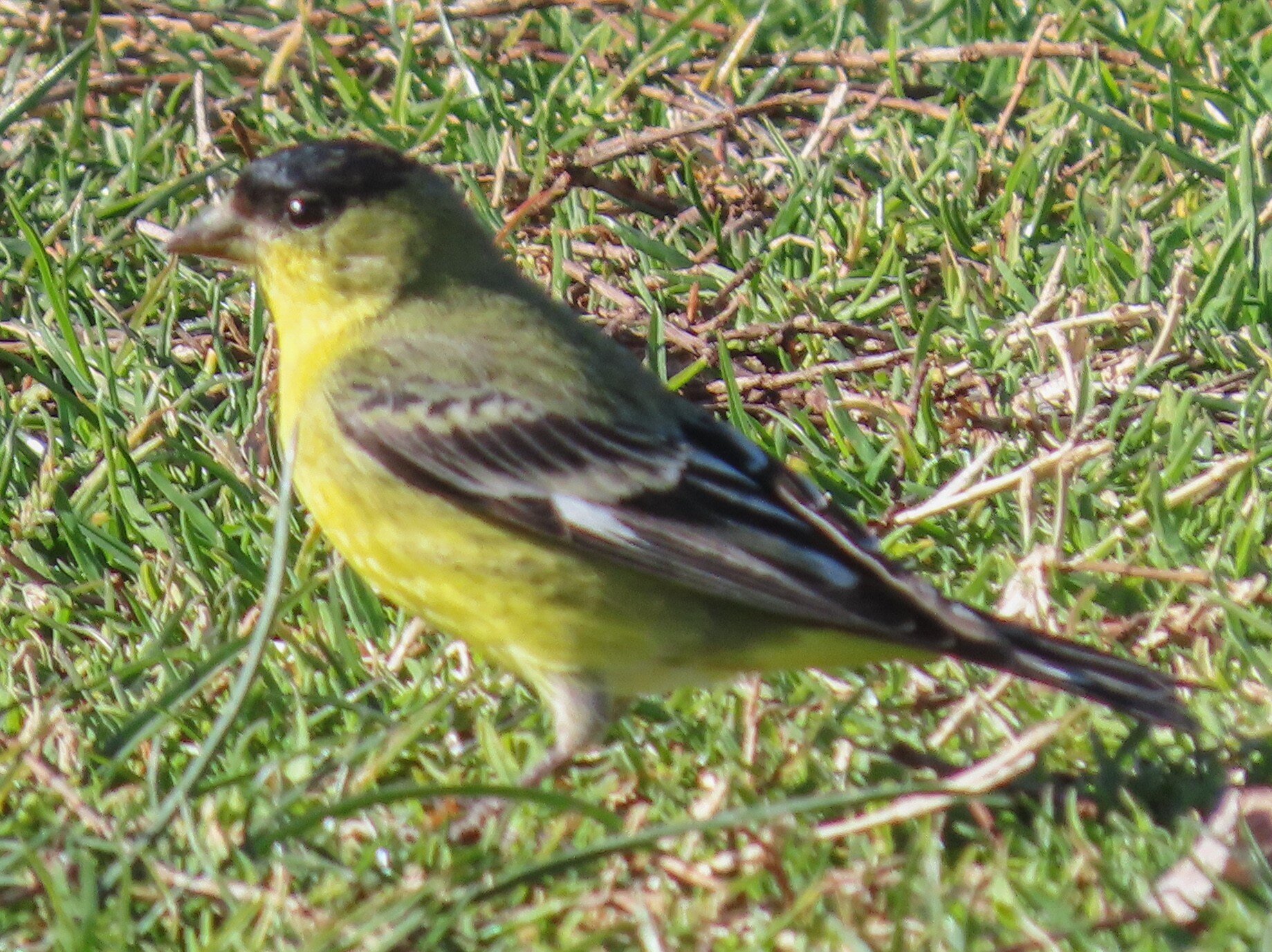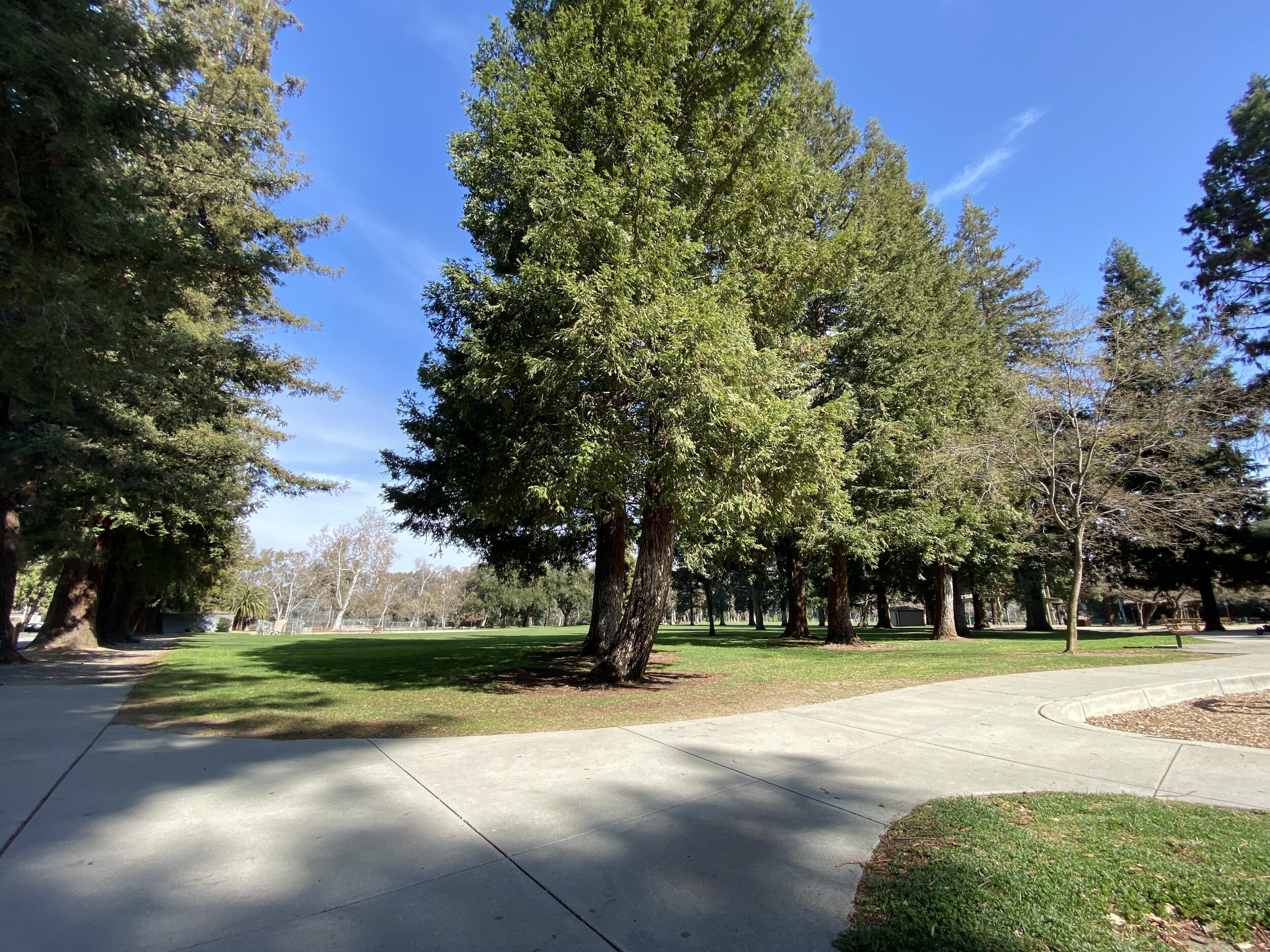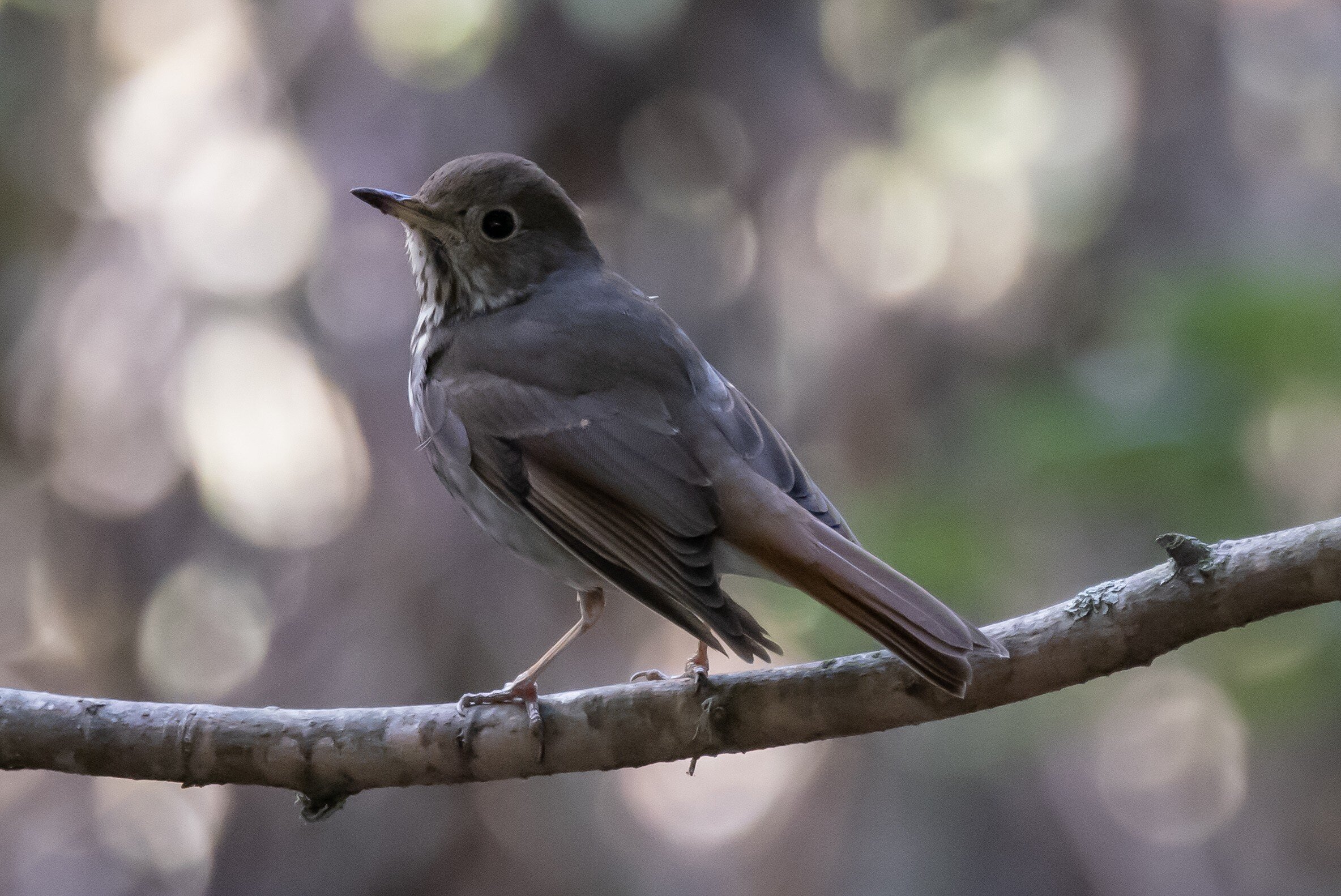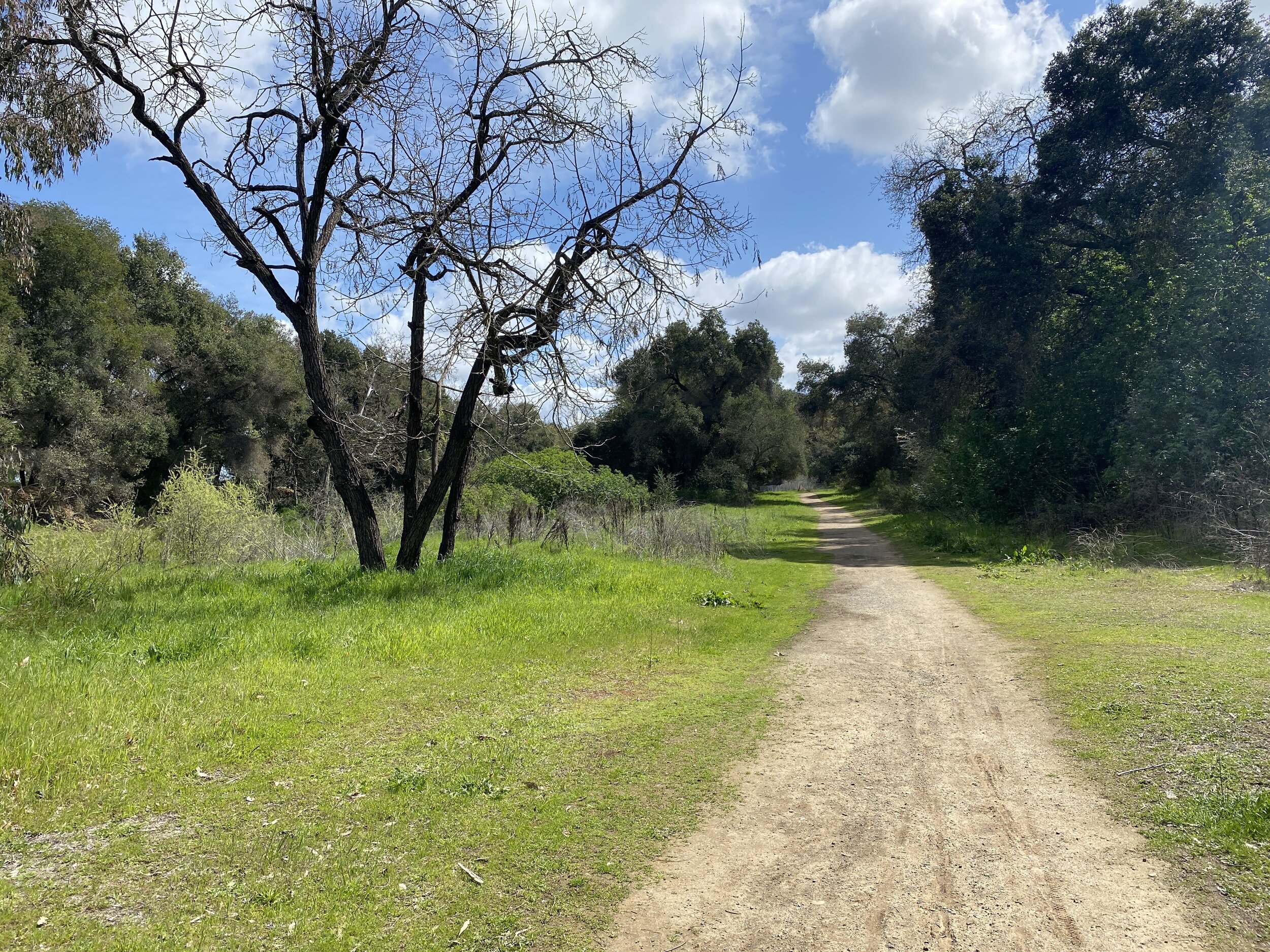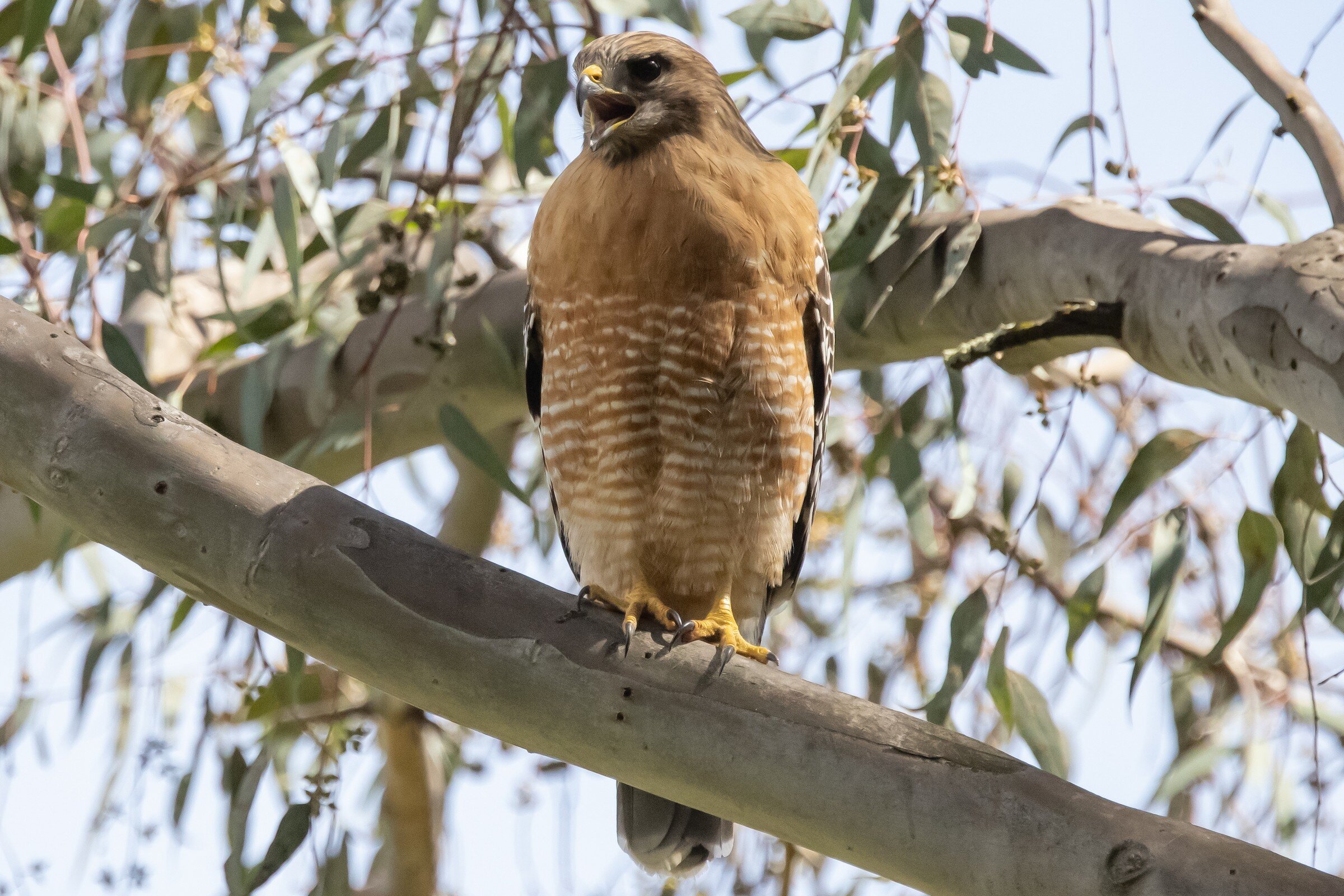Christmas Hill Park (Spring): A River Runs Through It.. for KIDS!
BY GINGER LANGDON-LASSAGNE
In the heart of garlic-growing Gilroy, this jewel of a park has some really top-notch, natural river habitat along Uvas Creek for both birds and kids to enjoy. The oak-bay woodland on the park’s namesake, Christmas Hill, provides plenty of places to explore steep trails with older kids, but even very young children can enjoy the birds on the lawn and in the trees at the playground area. Everyone, young and old, human or wildlife, is attracted to the beauty of a natural river. The combination of well-maintained city park and immediately-adjacent wildlife habitat makes this park perfect for a family outing… but the restrooms are CLOSED ON SUNDAYS.
Trip Covers: March - May
Key Birds: Red-shouldered Hawk, Acorn Woodpecker, Oak Titmouse, American Robin, Spotted Towhee
First things first— the playground is large, modern, and caters to both older and younger age groups. It’s also one of the best examples of handicapped-accessibility in play equipment I’ve seen! The foam ramp for wheelchairs to access the play areas were particularly noteworthy.
This location is good for being in nature when your kids desperately need some time outside, away from the computer screens. Come for the playground… stay for the creek. The best moments in a young life are often three big sticks, five pretty rocks, some trees to climb, and body of water.
The playground is surrounded by Coast Redwood, Incense Cedar, Red Alder and Black Walnut trees, planted in rows around the large lawn. These trees attract a variety of birds to the immediate vicinity of the playground. Lesser Goldfinches feast on the seeds of dandelions and tiny lawn daisies, but then have the safety of the thick redwood needles as refuge, if they feel threatened. American Robins hop-hop-hop-listen with a little tilt of their head, trying to detect the tasty worms that live under the turf.
Lesser Goldfinch photo by Barry Langdon-Lassagne
Anna’s Hummingbird photo by Barry Langdon-Lassagne
Male Anna’s Hummingbirds perch on the tips of bare branches and sing their scraping, squeaky-toy song, trying to keep others from straying into their personal territory. Hummingbirds sometimes prefer to build their nests in the small outer branches of redwood trees. Can you find a tiny nest, high in the branches? They’re super-camouflaged to protect them from predators, so if you do see one, consider yourself very lucky and sharp-eyed!
The paved path continues on from the playground area, further into the park… let’s go! Photo by Ginger Langdon-Lassagne
Along the trail here, as you follow the paved path deeper into the park, you will see a dense, native-oak forest, filled with thick underbrush and leaf litter. This is the perfect habitat for the Acorn Woodpecker. These loud, gregarious birds are easy to spot on the tops of the trees or even man-made light posts where they swoop out to catch flying insects for a tasty treat. As their name implies, they also eat a lot of acorns, of course. See if you can spot the tree they are using to store their cache!
Acorn Woodpecker photo by Ginger Langdon-Lassagne
Woodpeckers are not the only woodland birds you’ll find here along the right side of the trail. Many birds enjoy the deep cover provided by the bramble vines, poison oak thickets, and other low brush in the shade of the oaks. California Towhees and their brightly-marked cousins, the Spotted Towhees, are both experts in skulking and scratching under these thickets of branches. American Robins are residents of this park year-round, but are particularly noticeable in springtime when they sing and pair off for the nesting season. Hermit Thrushes are usually winter visitors here, but they stay in the area until mid-April, when they migrate to their summer breeding grounds. Look for the rusty tail of the Hermit Thrush, which contrasts with the back and wing feathers’ more grey-brown tones.
Spotted Towhee photo by Barry Langdon-Lassagne
Hermit Thrush photo by Barry Langdon-Lassagne
As you continue on the trail, you will arrive at the Amphitheater area. This is the location of the excellent restroom facilities, which are, unfortunately, closed on Sundays. The Amphitheater is a good place to just sit and listen for the songs of the birds. Can you recognize any that you know? Crows make a very familiar call: CAW-CAW-CAW-CAW!
Beyond the Amphitheater, the paved path ends. The other trails described here are varying levels of accessibility, from broad, flat gravel or packed-dirt lanes useful for most wheelchairs, to truly difficult, stair-steep and narrow tracks with encroaching poison oak!
They really aren’t kidding about the poison oak!
These trails above the Amphitheater are best for kids 8 and older.
Perhaps you’ll decide to brave the steep trails up Christmas Hill (recommended for older kids with careful judgement and a keen memory for what poison oak looks like in all its forms!) If so, springtime will reward you with some wildflowers on the sunny summit and a chance to scan the skies for Turkey Vultures, Red-tailed Hawks, and possibly even a Golden Eagle. (Just remember that it’s bath time for everyone when you get home, just in case.)
Fiddleneck, redmaids and lupine, atop Christmas Hill, March 16th, ‘21. Photos by Ginger Langdon-Lassagne
But perhaps instead of hiking up high to the hill, you’ll travel the flatter paths along the banks of the creek. The trail is not paved here, but unless there has been heavy rain, the packed-dirt surface is acceptable for wheeled travel in a stroller or wheelchair. The trees along the water provide shelter and food for a wide variety of birds, and on sunny spring days you can hear an enormous variety of birdsong here.
Before you go to the park, take a moment to familiarize yourself with a few of the spectacular calls made by one of the smaller, more drab denizens of this park. Except for the striking crest, there’s not much to distinguish the Oak Titmouse from… well… a little gray mouse? Listen to the song here:
Oak Titmouse photo by Barry Langdon-Lassagne. This is the same individual bird that is calling in the audio track included here!
Other birds you might hear along the banks of the creek include Hutton’s Vireo, Bewick’s Wren, Wilson’s Warbler, Pacific-Slope Flycatcher, and the rattling call of the Belted Kingfisher! Springtime is especially noisy, as many birds are choosing territories for nesting and raising a family, and that means yelling, “KEEP OUT” and “NO TRESPASSING” to other birds of their kind.
“MINE!” says the Red-shouldered Hawk. Photo by Barry Langdon-Lassagne
The very best part of any visit to Christmas Hill Park is the river. The shallow pool area, right where Miller Avenue crosses the creek is a marvelous place to play in the water. Mallards are commonly seen here, and by mid-May, they have a trailing troop of duckings in tow. If you sit quietly here for a while, you may catch a glimpse of that calling Belted Kingfisher, hunting up and down this stretch of the river. Listen carefully for the seagull-like cries of the Red-shouldered Hawk. You might even see a tall, white Great Egret come to stalk along the pond’s edge, hunting for frogs and minnows. Can you hear the frog? “creck-ek, creck-ek, creck-ek…”
This wild, natural river is one you’ll love to come back to, again and again, just as the birds do every year on their migrations.
Four marvelous kids playing together in Uvas Creek. They’re being gentle to the wildlife and also wearing their masks to protect everyone. They told me they come down to the river on their bikes, most days. Photo by Ginger Langdon-Lassagne (Permission for this photo’s publication on this site given by the kids photographed and each parent. No re-posting permitted.)
Interactive Map
Directions: From US-101 take exit 356 for 10th Street/CA-152 East. Proceed east on 10th Street for about a mile and a half, where the road turns slightly right and changes name to “Uvas Parkway.” In another 1/4 mile after the curve, turn left onto Miller Avenue. The park is immediately visible on the left. Latitude/Longitude: 36.997850, -121.584924
Parking: Extensive parking lots including ten spaces for handicapped placarded vehicles, three of these being van-accessible.
Fees: None, unless special event taking place.
Public Transportation: Public transit to this park is not terribly convenient, but it is possible. VTA bus 86 leaves the Gilroy Transit Center where several bus lines converge at the CalTrain Station, at 1/2 hour intervals, 7:15am to 3pm. Last returning bus at 3:30pm. It is just under a mile walk from the bus stop at 10th and Princevalle (Gilroy High School) to the park.
Park Hours: Park open 6am to 11pm from March through October. (Closes earlier at 8pm, November through February.) Restrooms open most of these hours, staffing permitting.
Facilities: Wheelchair accessible restroom with flush toilets, RESTROOM CLOSED SUNDAYS. Drinking fountain, trash cans, many picnic tables open for single households. Playgrounds are open. Decent-not-great cell phone service for all carriers in the playground & parking areas, less coverage down by the river banks and up on the trails on Christmas Hill.
Trip Mileage: 1 mile loop trail, circling the playgrounds and ball fields and returning along the banks of the river. Additional steep trails on Christmas Hill can add another 3/4 mile.
Trail Conditions: Flat, paved, wheelchair and stroller accessible paths & sidewalks in some areas, but also some dirt & gravel paths near the riverbanks that are unsuited for strollers or wheelchairs. Steep trails on Christmas Hill NOT RECOMMENDED for children under 8 due to extensive poison oak along trails. Many picnic tables suitable for resting, snacking, or nursing a baby. Flush toilets, sinks for hand-washing, and soap provided in restroom which is CLOSED ON SUNDAYS.
Accessibility: Very accessible in some areas, but also many dirt paths that are not wheelchair friendly. Not many park-bench type seats, but extensive picnic tables make up for much of this lack.
Bikes: Bikes very much recommended for the adjacent Debell Uvas trail and Levee Trail, both of which adjoin this park. Bikes not very useful for this park on its own, however, due to the shortness of the trails within the park that are suited to wheeled traffic.
Dogs: Allowed on leash
More Information
Christmas Hill Park Website from the City of Gilroy
eBird hotspot: Christmas Hill Park
All About Birds: Acorn Woodpecker and Oak Titmouse
City of Gilroy’s Clean Water/Environmental Conservation page
More Resources
For more trips like this one, visit Self-Guided Field Trips, especially recommending the winter-focused Christmas Hill/Debell Uvas trip for adult birders, by Rick Herder.
Visit the SCVAS Birding Resources page for more information on where to bird, our birding community, bird identification resources and more.
Read “What to Look for Now” by SCVAS Executive Director Matthew Dodder.
Banner Photo Credit: Ginger Langdon-Lassagne
Last Updated: 5/22/2022
Enjoyed this Trip?
Support the work of Santa Clara Valley Audubon Society and become a member. To contact the trip writer with comments, questions or location updates, please email fieldtrips@scvas.org. You can also post in the comment section below. (If you’d like to post anonymously, type your comment, select “Post Comment”, then simply provide a name, like “Guest”, and select “Comment as Guest”.)




